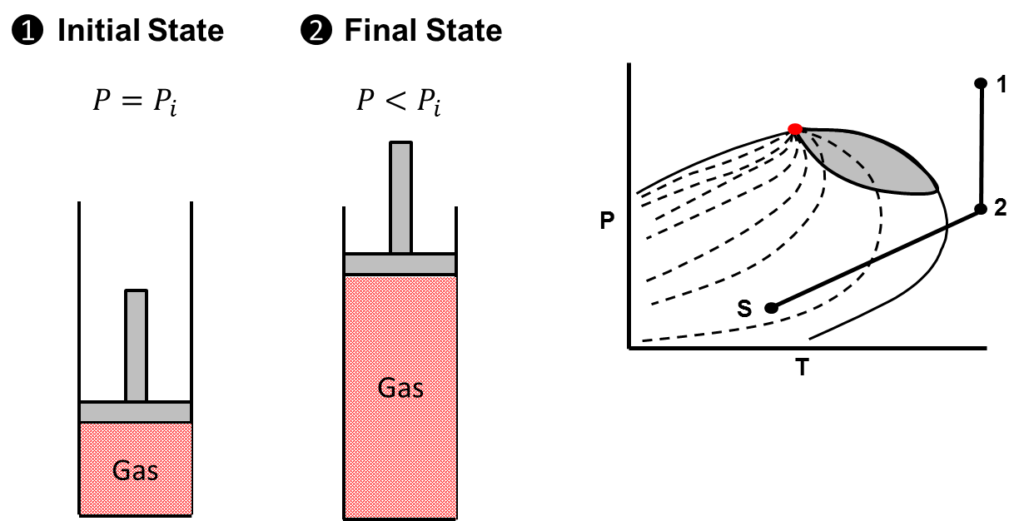A wet gas reservoir is a reservoir that contains only gas. However as the gas rises to the surface, liquid drops out due to a decrease in temperature. Once again, to produce the material balance equation for a wet gas reservoir, we must consider the initial state and current state of the reservoir. In the back of our mind we must also be able to picture the phase diagram for a wet gas reservoir. Consider the states of a wet gas reservoir as illustrated below:

From the figure above, it should be clear that at the initial reservoir pressure and final pressure, a wet gas reservoir only contains gas. As the fluid rises to surface, condensate drops out of the gas in the pipelines and separator at the surface as indicated by the phase diagram. The phase diagram of a wet gas reservoir shows the initial state indicated by the number 1 and the final state indicated by the number 2. Separator conditions are indicated by the letter “S”. Again, consider the macrocopic material balance equation. Because we know the reservoir states and general pressure decline path of a wet gas reservoir on a phase diagram, we can intelligently begin to eliminate terms that do not apply. The results are shown below:
(G_{fg})_i(\overbrace{\xcancel{B_{tg}}}^{B_i}-\overbrace{\xcancel{B_{tg_i}}}^{B_{g_i}})+\xcancel{N_i}({B_{to}}-B_{to_i}) + W_i(B_w-B_{w_i}) +v_fc_f(P_i-P) + W_e \\= (G_p-\xcancel{G_I})(\frac{B_g-B_oR_v}{1-R_v\xcancel{R_s}}) + N_p(\frac{B_o-B_g\xcancel{R_s}}{1-\xcancel{R_s}R_v})+\xcancel{(W_p-W_I)B_w}-
 = 0: no oil is initially in place
= 0: no oil is initially in place  = 0: assume no gas injected into the reservoir
= 0: assume no gas injected into the reservoir =undefined: no solution gas evolving out of the oil
=undefined: no solution gas evolving out of the oil = 0 : assume negligible water production
= 0 : assume negligible water production
After eliminating the unnecessary terms, the material balance equation for a gas condensate reservoir becomes the following:
(1)\;\;\;\;\; (G_{fg})_i(B_i-B_{g_i})+W_i(B_w-B_{w_i}) +v_fc_f(P_i-P) + W_e \\= G_p(B_g-B_oR_v) + N_pB_oThe above result should makes sense. We initially have gas in the reservoir, thus ![]() is defined. No matter how far the pressure declines, we always have single phase gas in the reservoir. Therefore, two phase gas formation volume factor
is defined. No matter how far the pressure declines, we always have single phase gas in the reservoir. Therefore, two phase gas formation volume factor ![]() gets converted to the single phase gas formation volume factor
gets converted to the single phase gas formation volume factor ![]() . On the phase diagram, as the fluid arrives to the surface, two fluids are produced: (1) oil condensate and (2) gas. Therefore
. On the phase diagram, as the fluid arrives to the surface, two fluids are produced: (1) oil condensate and (2) gas. Therefore ![]() is defined because liquid drops out of the gas.
is defined because liquid drops out of the gas. ![]() is defined because the condensate oil shrinks as it rises to the surface. Because the pressure decline path never enters the Therefore
is defined because the condensate oil shrinks as it rises to the surface. Because the pressure decline path never enters the Therefore ![]() ,
, ![]() , and
, and ![]() are defined. The reason
are defined. The reason ![]() is not defined is because the pressure decline path never enters the retrograde region (highlighted in gray). Therefore, the condensate that drops out at the surface does not revaporize. The equation below shows which terms are eliminated if one assumes a volumetric reservoir:
is not defined is because the pressure decline path never enters the retrograde region (highlighted in gray). Therefore, the condensate that drops out at the surface does not revaporize. The equation below shows which terms are eliminated if one assumes a volumetric reservoir:
- Assume volumetric reservoir:
 =0 ,
=0 ,  = 0, and
= 0, and  =0
=0
After eliminating terms with the volumetric assumption, the material balance equation for a volumetric gas condensate reservoir is the following:
(2)\;\;\;\;\;(G_{fg})_i(B_i-B_{g_i})= G_p(B_g-B_oR_v) + N_pB_oThere we have it! The macrocopic material balance equation combined with our knowledge of phase behavior results in a simple expression to describe the production of a wet gas reservoir. Next we will look at deriving the material balance equation for a dry gas reservoir.